
 |
|
|
#1 | |
|
Member
Join Date: Jul 2009
Location: Southern California, USA
Posts: 25
|
Hello from a new Member. I got this Kris at an auction here in the USA that had museum artifacts for sale. I'm trying to get the museum's contact information and see if they have the background history records of this Kris. I only have the 2 photos from the auction, but I will be getting more when the Kris arrives at my house.
All comments will be well appreciated. Any thoughts as to the age and area of origin? Quote:
Billy 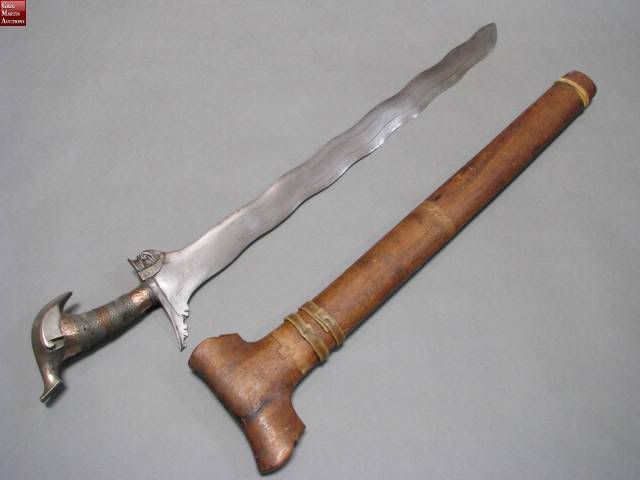 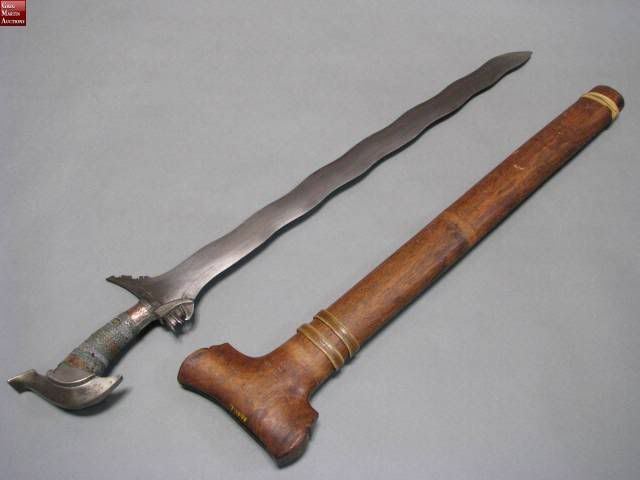
Last edited by Rick; 21st July 2009 at 06:09 PM. Reason: Moved from the Warung |
|
|
|

|
|
|
#2 |
|
Vikingsword Staff
Join Date: Nov 2004
Posts: 6,378
|
Welcome aboard, Billy .
 Need closeups please . Is the Kakatua solid metal ? First impression I get is Sulu origin .  Nice ..... Last edited by Rick; 21st July 2009 at 06:21 PM. |
|
|

|
|
|
#3 |
|
Member
Join Date: Oct 2007
Posts: 2,818
|
Congrats,
I good looking nice complete piece. I was going to bid on this piece but I fell asleep (time differences). Is it silver or nickel plated as the auction house noted? Gav |
|
|

|
|
|
#4 |
|
Member
Join Date: Jul 2009
Location: Southern California, USA
Posts: 25
|
The auction was 3 days ago. I have not received an Invoice yet, so I am not sure when my Kris will arrive. When it does I hope I can provide more details and (of course) close-up photos.
Billy |
|
|

|
|
|
#5 |
|
EAAF Staff
Join Date: Dec 2004
Location: Louisville, KY
Posts: 7,363
|
The blade does look Sulu.
|
|
|

|
|
|
#6 |
|
Vikingsword Staff
Join Date: Nov 2004
Posts: 6,378
|
Looking forward to your pictures; don't forget a closeup of the sorsoran, or base of the blade .
I wonder if the other color on the hilt may be Swassa . It may even have a core; include a closeup of the blade too !!  This one looks nice . Rick |
|
|

|
|
|
#7 |
|
EAAF Staff
Join Date: Dec 2004
Location: Louisville, KY
Posts: 7,363
|
O yes, I forgot - I doubt that the pommel is solid - it would be too heavy!

|
|
|

|
|
|
#8 |
|
Member
Join Date: Jul 2009
Location: Southern California, USA
Posts: 25
|
I got my Kris yesterday! I will start with this Post on the blade. Forgive me if I butcher the different names of the parts, but this is my 1st genuine (I believe) Kris. I go to the Philippines at least yearly and I've seen many "tourist" Kris for sale, but this is my 1st experience holding one. I will refer to the Left and Right sides looking down towards the tip while holding it.
For those of you that want to jump ahead, I have 45 photos here: http://s26.photobucket.com/albums/c119/aerosick/Kris/ Measurements and Details: The laminated (?) blade is a fully waved with 13 waves. Has a talisman chiseled into the blade. Total Weight of Kris and Scabbard = 2 lbs 1 oz ~ 936 grams Weight of Kris = 1 lb 5 oz ~ 595 grams Weight of Scabbard = 12 oz ~ 340 grams Overall Length = 27.625” ~ 700 mm Length of Blade = 22” ~ 560 mm Width of Blade at Balance (4.25” ~ 108 mm below Guard) = 1.4” ~ 36 mm Depth of Blade at Balance = 0.2” ~ 5 mm Hilt Length = 5.625” ~ 140 mm Width of Guard (Gangya) = 4.25” ~ 108 mm Left Side 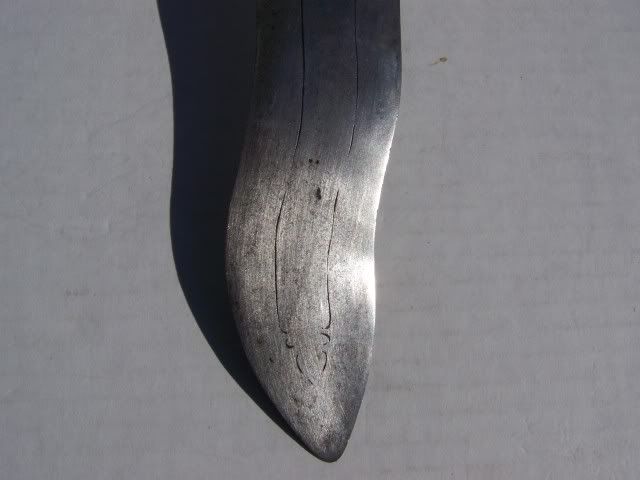 Right Side 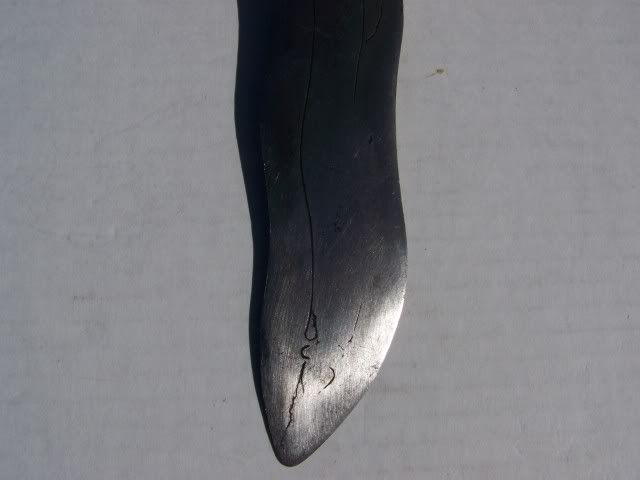 Left Top 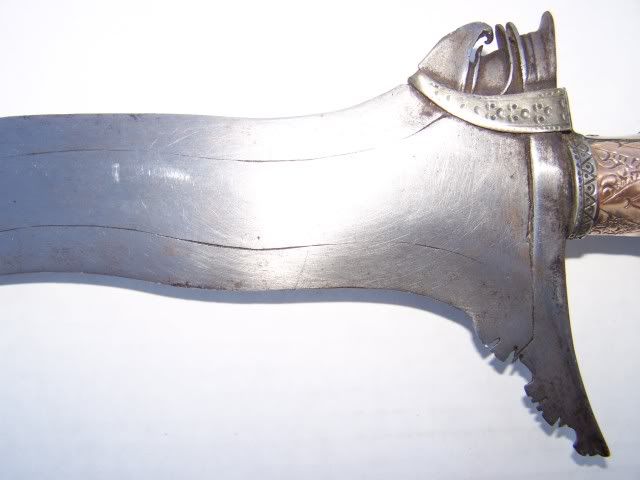 Right Top 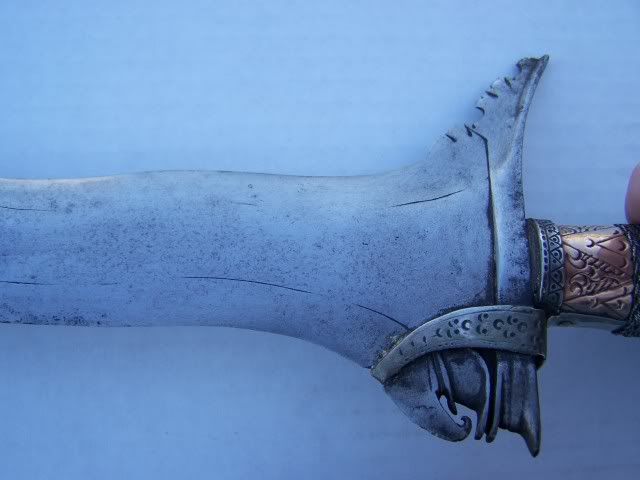
|
|
|

|
|
|
#9 |
|
Keris forum moderator
Join Date: Aug 2006
Location: Nova Scotia
Posts: 7,263
|
Hey Billy. Nice to see you on this forum. I think you might get some more responses here.
 So, have you tested the pommel material yet? Some close-ups of the hilt might be good. I also wonder if the ferrule might be suasa (a low carat gold with a lot of copper in it) instead of copper. How well does the blade fit into the scabbard? Is it well fitted around the mouth? |
|
|

|
|
|
#10 | |
|
Member
Join Date: Jul 2009
Location: Southern California, USA
Posts: 25
|
Quote:
I have not tested the pommel material yet. I'm going slow and need to learn more about the testing. The blade fits the scabbard very well around the mouth and also at the bottom. The mouth of the scabbard where the long end of Gangya sits shows that maybe the tip of the Gangya might have broken off. I will take more photos tomorrow in good light. 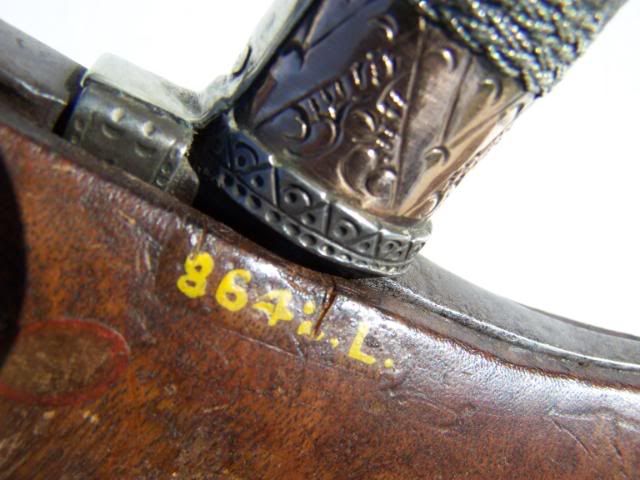 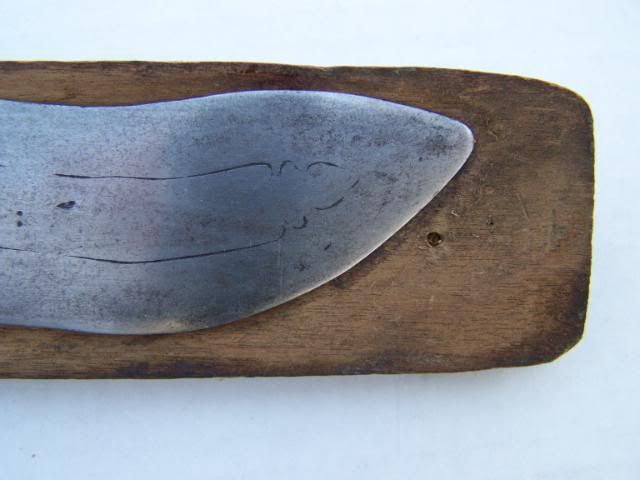 
|
|
|
|

|
|
|
#11 | |
|
Member
Join Date: Jul 2009
Location: Southern California, USA
Posts: 25
|
Quote:
The silver and copper (my guess so far) braided wires have just a few broken spots. The copper wire is pliable. You can see the museum's tape on it. The lower tape has their record number 8642.L and the scabbard has the number 8641.L. 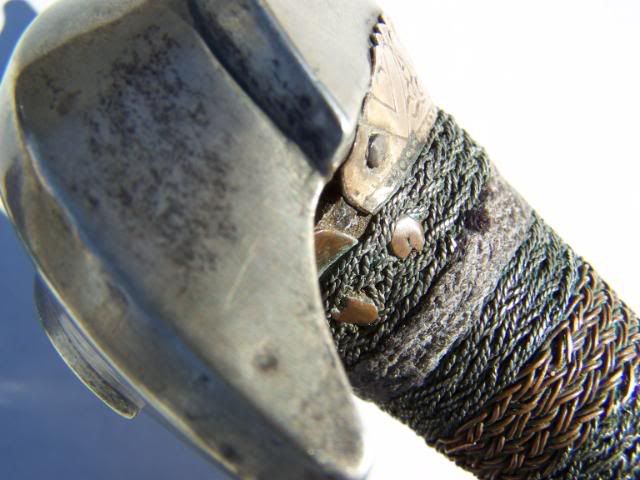 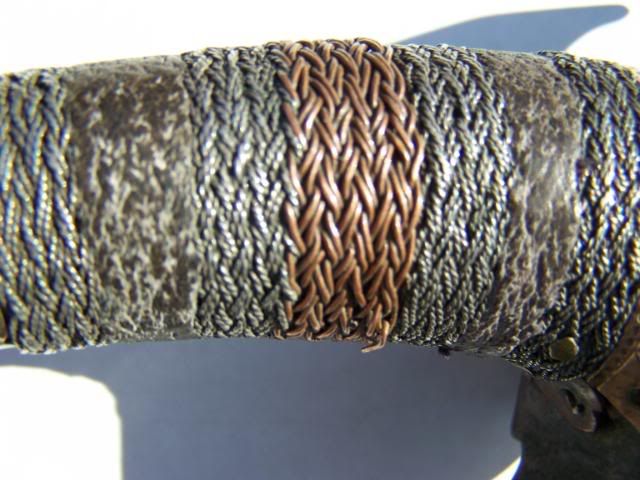 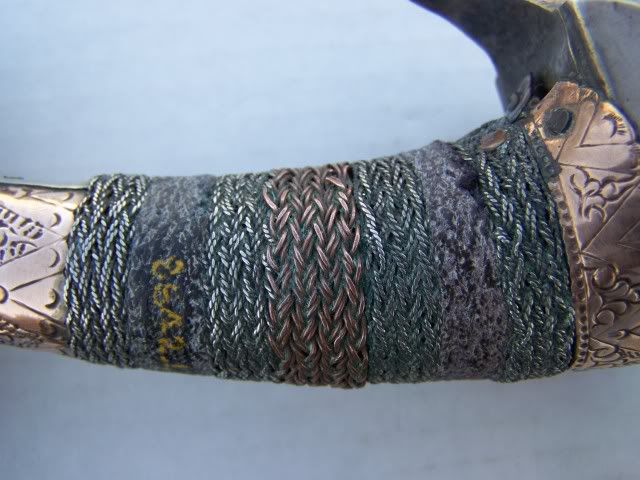
|
|
|
|

|
|
|
#12 |
|
Vikingsword Staff
Join Date: Nov 2004
Posts: 6,378
|
This one may have a twist core .
I believe it is likely pre 20th C. Just an observation though ....  There's something funny about the tip . Possibly it has been reshaped during it's working life ?  A possibility with an old blade . I don't believe that this is its first hilting . Nice . Last edited by Rick; 2nd August 2009 at 02:00 AM. |
|
|

|
|
|
#13 |
|
Member
Join Date: Jul 2009
Location: Southern California, USA
Posts: 25
|
The Gangya (guard) looks to be a separate piece, not part of the blade. It has a single clamp (baca-baca).
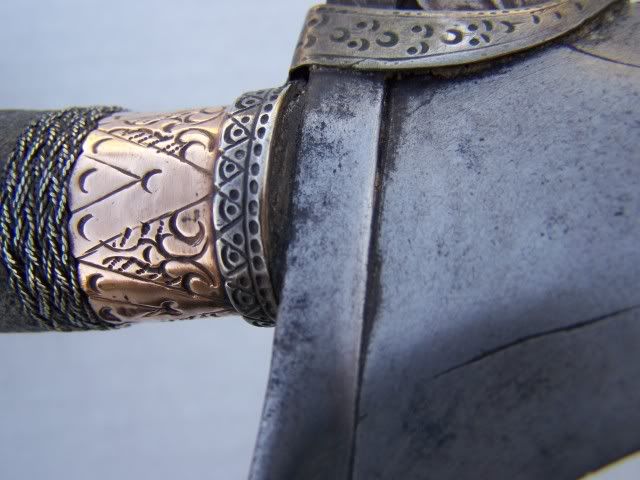 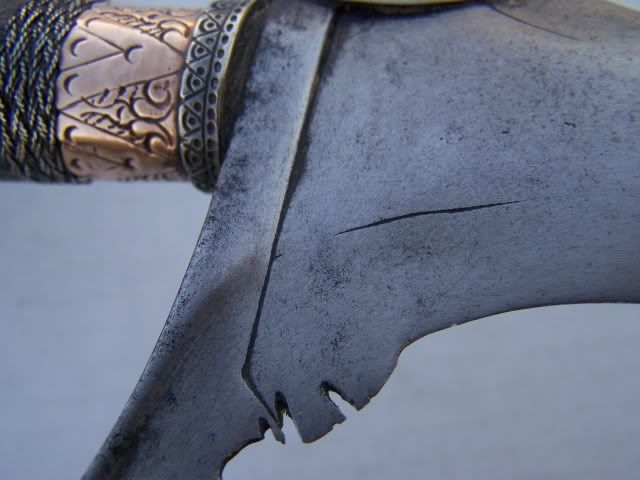 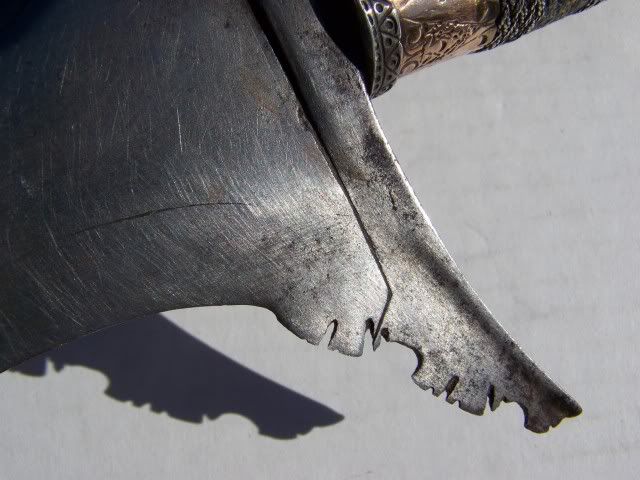 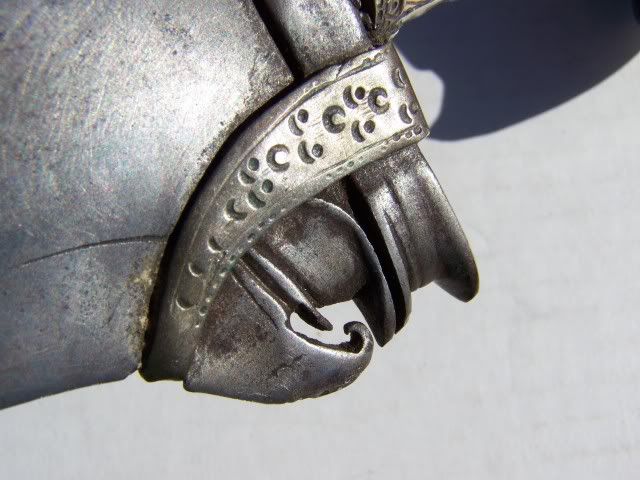
|
|
|

|
|
|
#14 | |
|
Member
Join Date: Jul 2009
Location: Southern California, USA
Posts: 25
|
Quote:
Edit: The scabbard could have been made later to fit the blade. Billy The pattern in the blade seems to follow the tip. Should the tip be more rounded as a "slasher", not a "stabbing" blade? The tip fits snug in the scabbard's hollowed out tip area. (That photo is in an earlier Post of mine) Billy  
Last edited by aerosick; 2nd August 2009 at 02:34 AM. |
|
|
|

|
|
|
#15 |
|
Vikingsword Staff
Join Date: Nov 2004
Posts: 6,378
|
See my edit in the post above .
Here is a blade that I think may be from the same time frame as yours .  http://www.arscives.com/historysteel...1/160-rb3a.jpg |
|
|

|
|
|
#16 | |
|
Member
Join Date: Jul 2009
Location: Southern California, USA
Posts: 25
|
Quote:
Billy |
|
|
|

|
|
|
#17 |
|
Vikingsword Staff
Join Date: Nov 2004
Posts: 6,378
|
Indeed; but compare the distance between the engraving and the point . Compare the point shape with your example .
 Check the rest of the krisses on the site also . http://www.arscives.com/historysteel...nes.swords.htm Your's is an old blade; I'm fairly certain of that .  It may even have a twist core . Nothing wrong with keeping an old warrior functional . If the point was modified it was long ago I figure . |
|
|

|
|
|
#18 | |
|
Member
Join Date: Jul 2009
Location: Southern California, USA
Posts: 25
|
Quote:
 Can you point me to a reference on "twist core" versus other forge techniques? Is this where they would twist the metal billets? Does this make it rarer? Thanks, Billy |
|
|
|

|
|
|
#19 |
|
EAAF Staff
Join Date: Dec 2004
Location: Louisville, KY
Posts: 7,363
|
I looked at the pictures in your link and compared the copper wire and nails to the top and bottom chased okired pieces. I think the top and bottom pieces are indeed swassa.
The place to test them would be at a jewelers (besides me). Also the blade is probably older than the hilt. Not unusual. |
|
|

|
|
|
#20 |
|
Member
Join Date: Jul 2009
Location: Southern California, USA
Posts: 25
|
In a small hole that didn't show well in the photos I can almost see wood under where the cockatua joins the hilt.
Could the cockatua be silver or a mix? Do you think that the cockatua is small or medium size? Is this a shape found in pre-20th Century? Billy  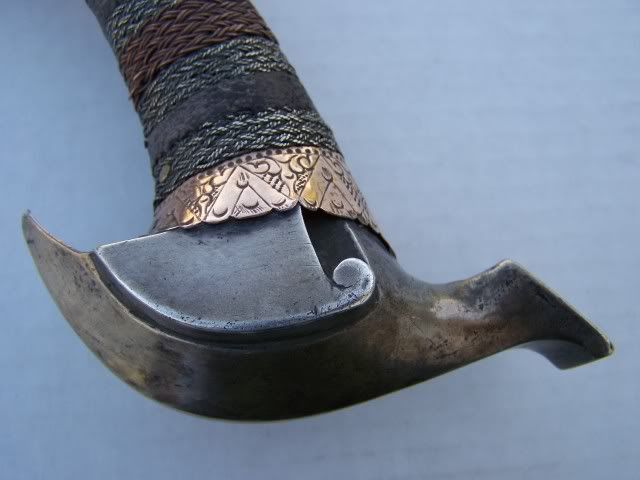 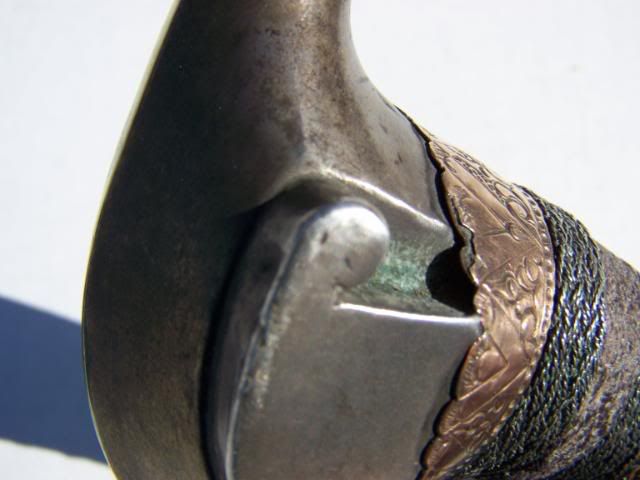 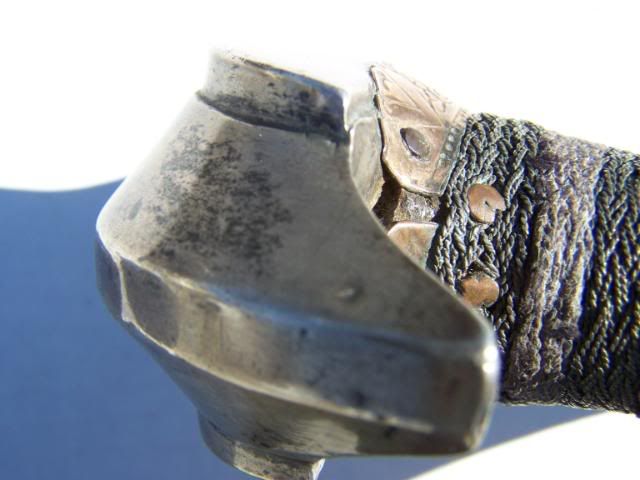
|
|
|

|
|
|
#21 | |
|
Member
Join Date: Jul 2009
Location: Southern California, USA
Posts: 25
|
Quote:
Billy |
|
|
|

|
|
|
#22 | |
|
Keris forum moderator
Join Date: Aug 2006
Location: Nova Scotia
Posts: 7,263
|
Quote:
You can easily purchase silver test solution. Test for gold content might require a jeweler. |
|
|
|

|
|
|
#23 |
|
EAAF Staff
Join Date: Dec 2004
Location: Louisville, KY
Posts: 7,363
|
I would guess from the pictures that the pommel would be a coin silver from the looks in the pictures. IT looks large but right for a pre-20th century piece.
|
|
|

|
|
|
#24 | |
|
Member
Join Date: Jul 2009
Location: Southern California, USA
Posts: 25
|
Quote:
From long end of Guard (Gangya) to the top of the head = 5.32” ~ 13.5 cm From Underside of Cockatua on Wide Side to Guard (Gangya) = 4.55” ~ 11.56 cm From Underside of Cockatua on Narrow Side to Guard (Gangya) = 3.22” ~ 8.18 Rectangular beak Height = 1.05” ~ 2.67 cm Width: Top Across Widest Area = 0.78” ~ 1.98 cm Bottom Across Widest Area = 0.62” ~ 1.57 cm Widest area of the Cockatua is at the eyes = 1.83” ~ 4.65 cm Billy 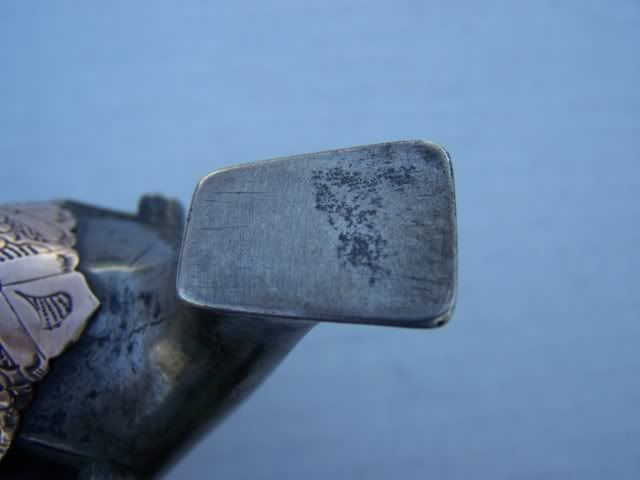 
|
|
|
|

|
|
|
#25 |
|
Vikingsword Staff
Join Date: Nov 2004
Posts: 6,378
|
I think this pommel would qualify as danganan style in size according to Cato's Moro Swords fig. 45 pg 74 .
|
|
|

|
|
|
#26 | |
|
EAAF Staff
Join Date: Dec 2004
Location: Louisville, KY
Posts: 7,363
|
Quote:
|
|
|
|

|
|
|
#27 |
|
Member
Join Date: Jul 2009
Location: Southern California, USA
Posts: 25
|
I see where the pommel is more in the shape of the sarimanok bird rather than the cockatua. My wife is originally from Cebu, Philippines. I asked her if she had ever heard of the mythical "sarimanok" bird. She said "Sure! It's the Logo of a Philippine TV Network"!
 Billy |
|
|

|
|
|
#28 | |
|
Member
Join Date: Feb 2007
Location: Kaboejoetan Galoenggoeng Mélben
Posts: 476
|
Quote:
- The original meaning of 'sarimanok' was 'essentially/fundamentally bird', referring to the pommel's general shape. - As for 'cockatua', the original meaning was 'spiny parrot', referring to the head-plumage, which resembles spines/spikes. Best, |
|
|
|

|
|
|
#29 | |
|
Member
Join Date: Jul 2009
Location: Southern California, USA
Posts: 25
|
Quote:
Thanks! Billy |
|
|
|

|
|
|
#30 |
|
Member
Join Date: Jul 2009
Location: Southern California, USA
Posts: 25
|
test uploaded photo re-sized to 320 pixels
|
|
|

|
 |
| Thread Tools | Search this Thread |
| Display Modes | |
|
|